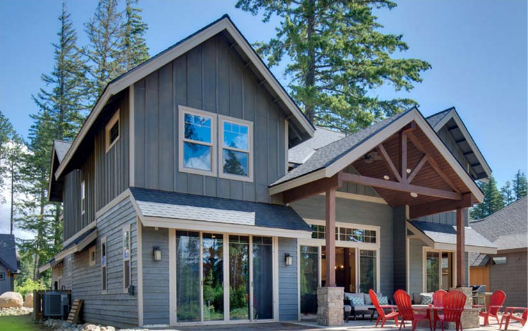Vertical vs Hortizontal Exterior Home Siding: 5 Differences

When it comes to the exterior of your home, choosing the right siding is crucial. Not only does it protect your home from the elements, but it also plays a significant role in enhancing its aesthetic appeal. With a multitude of options available, it can be overwhelming to decide which siding is best suited for your needs. Two popular choices that homeowners often consider are vertical and horizontal siding. In this article, we will explore the differences between the two and provide insights into the pros and cons of each, helping you make an informed decision.
The importance of choosing the right siding for your home
The exterior of your home is the first thing people notice, and it sets the tone for the overall impression of your property. Choosing the right siding is essential for various reasons. Firstly, it protects your home from the harsh elements, such as rain, snow, and wind. A quality siding material, such as beautiful James hardie siding in Denver, acts as a barrier, preventing moisture from seeping into your home and causing damage.
Secondly, siding enhances the energy efficiency of your home by providing insulation. This helps regulate the temperature inside, reducing the need for excessive heating or cooling. Lastly, the right siding can significantly increase the curb appeal and value of your home, making it more attractive to potential buyers if you ever decide to sell.
Understanding the differences between vertical and horizontal siding
Before delving into the pros and cons of vertical and horizontal siding, it’s important to understand the basic differences between the two. Vertical siding, as the name suggests, is installed in a vertical orientation, with the panels running from the top to the bottom of your home’s exterior. On the other hand, horizontal siding is installed horizontally, with the panels running parallel to the ground. These differences in orientation can have a significant impact on the overall appearance and functionality of your home’s exterior.
Pros and cons of vertical siding
Vertical siding offers several advantages that make it an appealing choice for many homeowners. One of the key benefits is its ability to create the illusion of height. If you have a low-ceilinged house or want to make your home appear taller, vertical siding can help achieve that effect.
Additionally, vertical siding has better water resistance compared to horizontal siding. The vertical orientation of the panels allows water to drain more effectively, reducing the chance of water damage. However, one drawback of vertical siding is that it requires more maintenance. The vertical orientation makes it more prone to dirt and debris buildup, requiring regular cleaning to maintain its appearance.
Pros and cons of horizontal siding
Horizontal siding, on the other hand, offers its own set of advantages and disadvantages. One of the main benefits of horizontal siding is its ease of installation. The panels can be installed quickly and efficiently, saving both time and labor costs. Additionally, horizontal siding is less prone to dirt and debris buildup, as the orientation allows for natural water runoff.
This makes it a low-maintenance option for homeowners who prefer a hassle-free exterior. However, horizontal siding may not be suitable for all architectural styles. It may not complement certain designs, making it less versatile compared to vertical siding. Furthermore, horizontal siding can be more susceptible to water damage if not properly installed or maintained.
Factors to consider when choosing between vertical and horizontal siding
When deciding between vertical and horizontal siding, there are several factors you should consider. Firstly, consider the architectural style of your home. Some architectural styles are better suited for vertical siding, while others may look more appealing with horizontal siding. Secondly, think about the climate in your area. If you live in an area with heavy rainfall or high humidity, vertical siding may be a better choice due to its superior water resistance. Thirdly, consider your personal preference and the desired aesthetic of your home. Take into account factors such as color, texture, and overall visual appeal. Lastly, consider the maintenance requirements of each siding option. If you prefer a low-maintenance exterior, horizontal siding may be the better choice for you.
Popular types of vertical siding
There are several popular types of vertical siding to choose from, each with its own unique features and benefits. One of the most common options is board and batten siding. This type of siding features wide vertical boards with narrower boards, known as battens, covering the seams. It provides a classic, rustic look and is often used in traditional or farmhouse-style homes.
Another popular choice is vertical metal siding, which offers durability and a sleek, modern appearance. Metal siding is available in various materials, such as aluminum, steel, or zinc, each with its own advantages. Other options include vertical vinyl siding, fiber cement siding, and cedar shingles, each offering their own set of benefits and aesthetic appeal.
Popular types of horizontal siding
When it comes to horizontal siding, there are also several popular options to consider. One of the most common choices is vinyl siding, which is known for its affordability, durability, and low maintenance. Vinyl siding is available in a wide range of colors and styles, making it a versatile option for various architectural styles. Another popular option is fiber cement siding, which offers the look of wood without the maintenance requirements. Fiber cement siding is resistant to rot, insects, and fire, making it a durable choice for homeowners. Other options include wood siding, aluminum siding, and stucco, each with its own unique features and aesthetic appeal.
Tips for maintaining and caring for your chosen siding
Regardless of whether you choose vertical or horizontal siding, proper maintenance is crucial to keep it looking its best and functioning effectively. Here are a few tips to help you maintain and care for your chosen siding:
- Regularly clean your siding to remove dirt, debris, and mildew. Use a soft brush or a pressure washer on a low setting, ensuring not to damage the siding material.
- Inspect your siding for any signs of damage, such as cracks, rot, or loose panels. Repair or replace any damaged sections promptly to prevent further issues.
- Protect your siding from moisture by ensuring proper drainage around your home’s foundation. Clean gutters and downspouts regularly to prevent water from backing up and causing damage.
- Consider applying a protective coating or sealant to your siding. This can help prolong its lifespan and protect it from the effects of UV rays, moisture, and other environmental factors.
- If you live in an area prone to extreme weather conditions, such as hurricanes or heavy snowfall, consider reinforcing your siding with additional measures, such as impact-resistant panels or storm shutters.
Conclusion: Making the right choice for your home’s exterior
Choosing the best exterior home siding for your needs requires careful consideration of various factors. Whether you opt for vertical or horizontal siding, both options offer their own unique advantages and disadvantages. Consider the architectural style of your home, the climate in your area, and your personal preferences when making your decision.
Additionally, ensure proper maintenance and care to prolong the lifespan and appearance of your chosen siding. By taking these factors into account, you can make an informed choice and enhance the beauty and functionality of your home’s exterior.
Read more here for more information.





